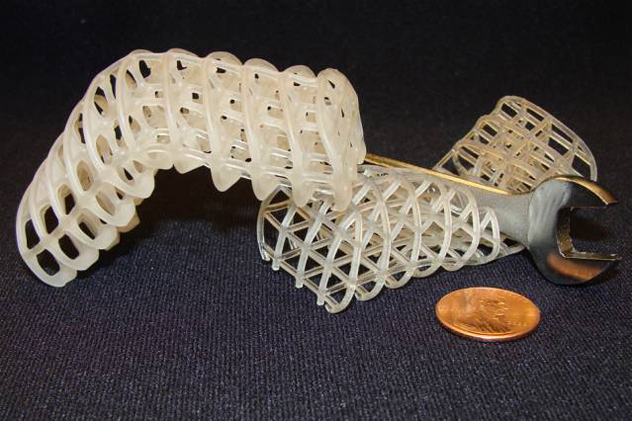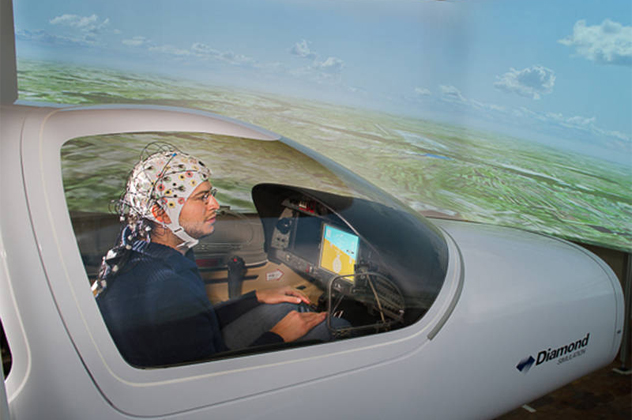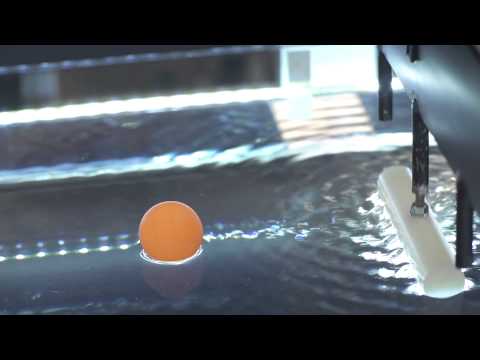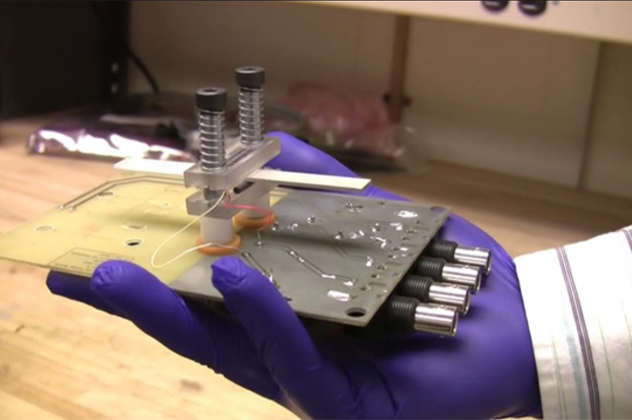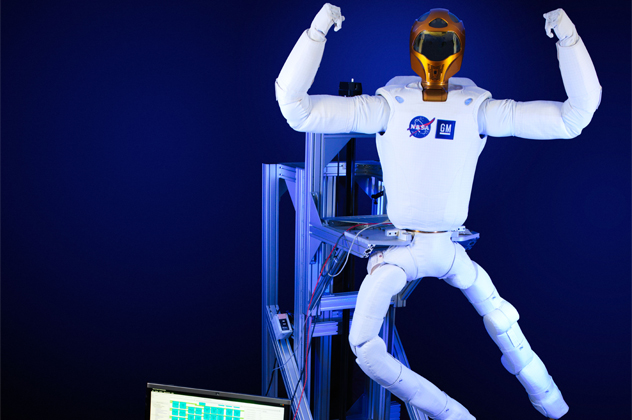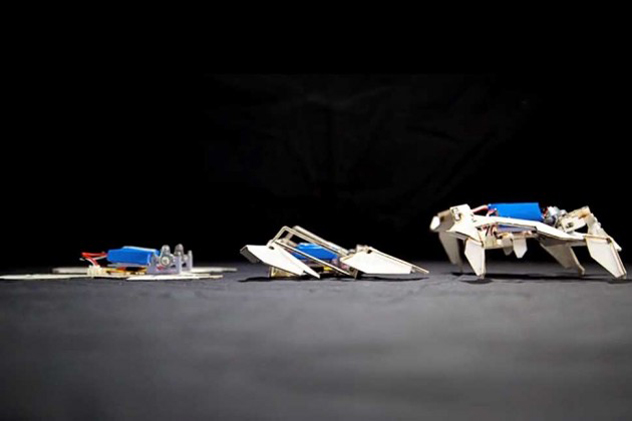10Squishy Robots
If you’ve watched the movie Terminator 2 then you’ve seen the T-1000 robot squeeze through tight areas by changing into a liquid. It could repair itself that way, too. Now, scientists from the Massachusetts Institute of Technology have made their own version of the shape-shifting T-1000 a reality. The Defense Advanced Research Projects Agency (DARPA) wanted deformable (or “squishy”) robots that acted like an octopus. That means they could squeeze through tight spaces and enlarge afterward to move around a larger space. In a surgical setting, a squishy robot would be able to move to a certain point in a human body without causing damage to blood vessels or organs. Then it could perform the necessary surgical task. In a search-and-rescue operation, a squishy robot could squeeze through rubble to find survivors. To achieve these goals, scientists needed a material that could shift between a hard state (when the robot would handle tools or perform other tasks) and a soft state (when the robot would squeeze under or between objects). As Anette Hosoi, an MIT professor, said in a news release, “You can’t just create a bowl of Jell-O, because if the Jell-O has to manipulate an object, it would simply deform without applying significant pressure to the thing it was trying to move.” Ultimately, the scientists chose a low-cost, polyurethane foam which could squeeze to an extremely small size and expand to its normal shape afterward. Then they coated it with wax that’s cheaply available in craft stores. By applying medium heat to wires running along coated foam struts, the wax could morph from a hard shell to a soft surface. The current could be turned on and off as needed. When heat was applied to the wax, the robot would also repair itself automatically.
9Mind Control Of Inanimate Objects
In “Spock’s Brain,” an episode from the original Star Trek series, a beautiful Eymorg extracted the brain from Mr. Spock’s body and used it to control things like air circulation in the underground complex where her people lived. Successfully removing someone’s brain to run a building may seem far-fetched, but controlling an inanimate object with your thoughts has become reality. The goal of a project called “Brainflight,” which is funded by the European Union, is to control an airplane using only the signals from a human brain. The researchers want to make flying easier, cheaper from a training standpoint, and accessible to more people. They believe this will increase safety by reducing the burden on current pilots. The initial test results have been amazingly accurate. While wearing a cap with electroencephalography (EEG) electrodes attached, a pilot’s brain waves are converted into commands for the aircraft. The pilot never touches the equipment or controls. Instead, they appear to move by themselves. But it’s not mind reading, just signal processing determined by an algorithm developed by the researchers. The position of the plane will repeatedly correct until it lands smoothly—all through mind control. Seven people with various levels of experience participated in flight simulator tests. One participant had no real cockpit experience, but everyone was precise enough in their thought commands to pass the flying portion of a pilot’s license test. Many of the participants were even able to land smoothly under conditions of poor visibility.
8Weather Modification
On Star Trek: The Next Generation and other sci-fi shows, the characters sometimes mentioned “scientific” techniques that would stop tornadoes or modify the weather in other ways. But they were just creations from a writer’s imagination. Even in our world, some people make up conspiracy theories about weather modification. Well, they’re about to get something real to talk about. Researchers from the University of Central Florida and the University of Arizona are enhancing a way to shoot a high-energy laser beam into the clouds to produce rain or lightning on demand. Other researchers have been able to cause an electrical event in the clouds, although they couldn’t trigger a bolt of lightning. The Florida and Arizona researchers faced at least a couple of problems. First, they had to make sure that this type of high-energy laser beam didn’t fizzle out before it reached the target. They also needed to aim the beam from a safe distance to avoid being struck by lightning. To solve these problems, they decided to use a secondary laser beam to surround and sustain the high-intensity primary beam. With the secondary laser acting as an energy reservoir, the primary laser beam could travel much farther than before. It’s like using a laser extension cord to reach the clouds. With their method, they’ve extended the reach of the laser from 25 centimeters (10 in) to at least two meters (7 ft). But they believe it’s possible to go 50 meters (165 ft) or more. This would allow us to control rain and lightning over a vast area.
7Tractor Beams
Tractor beams that use energy to pull objects toward you or your ship are commonly used in science fiction, especially in Star Wars and Star Trek. But for a long time, it seemed contrary to the laws of physics in the real world. Recently, though, scientists at Australian National University developed a tractor beam on water. According to the leader of the team, Dr. Horst Punzmann, they “figured out a way of creating waves that can force a floating object to move against the direction of the wave.” In other words, this wave-generated tractor beam draws the item to it. Watch this video on YouTube Using a wave tank, the scientists figured out how to move a ping pong ball in the direction they wanted by manipulating the frequency and size of the waves generated. They discovered that these three-dimensional waves cause currents on the water’s surface in different patterns. One of those patterns is a tractor beam that should be useful in containing oil spills or maneuvering objects adrift in the water. Physicists at the University of Dundee have also developed an acoustic tractor beam that’s able to move an object of 1 centimeter (0.4 in) in size. Until now, only microscopic objects have been moved with this type of beam. The scientists were able to use ultrasound energy to exert force behind the object and move it toward the ultrasound device. They believe that this technology will significantly advance the use of ultrasound in healthcare.
6Tricorders
Another Star Trek device is the tricorder, a handheld scanner that was often used by Dr. McCoy to scan patients when making a medical diagnosis. Other characters used tricorders to scan for life forms or to analyze planet surfaces. In our world, the technology now exists to make certain types of tricorders a distinct possibility in the near future. At the University of Southampton, scientists are developing a handheld medical scanner that uses electronic components as chemical sensors. That would allow for same-day diagnosis of protein samples from a patient’s bedside. These scanners reduce the cost and time needed to get a patient their treatment by eliminating the need to send samples to a lab. Other scientists at the University of Missouri are developing another type of tricorder that uses a radiation source as small as a stick of gum. Their tricorder would be a handheld X-ray scanner that could be used for medical X-rays, for fighting terrorism, or even for interplanetary exploration. The scanner itself would be the size of a cell phone. In addition to reducing medical expenses, this tricorder could bring much needed X-ray diagnostic services to patients in poor, remote areas. It could also be used for dental X-rays that reduce the patient’s exposure to radiation. To fight terrorism, this tricorder could search cargo for weapons and other illegal items at points of entry into a country. Plus, these scanners could be designed with sensors to help in exploring planets, either our own or others if used on interplanetary probes.
5Biometric Payments With Vein Scanning
It’s commonplace in science fiction to use retina scans or other biometric methods to access top-secret information, like with Project Genesis on Star Trek II: The Wrath of Khan. Now Fredrik Leifland, an engineering student at Sweden’s Lund University, has taken that concept and applied it to biometric payments that access secure bank accounts. As of April 2014, there were 15 restaurants and stores in Sweden that used Leifland’s vein-scanning technology to take payments from a customer’s bank account. At that time, about 1,600 customers were actively using the system as an alternative to paying with cash or credit cards. This vein-scanning payment method is supposed to be easy, quick, and secure. As Leifland said in a Lund University article, “Every individual’s vein pattern is completely unique, so there really is no way of committing fraud with this system. You always need your hand scanned for a payment to go through.” Signing up for hand payments appears to be fairly easy. You go to a store with a vein-scanning terminal. Then you enter some personally identifying information and scan your hand three times. You get a text message with an activation link. Finally, you complete a registration form with all the necessary banking information and you’re good to go.
4Robonauts With Space Legs
Human-like robots have been a mainstay in science fiction films, TV, books, and comic books. They run the gamut from Astro Boy to C-3PO and beyond. In the real world, we have Robonaut, a robot designed by General Motors and NASA which we told you about before. But the human-like Robonaut 2 (R2) is now taking the next step. The R2 robot aboard the International Space Station (ISS) originally had just a head and torso with two arms and hands. That meant astronauts had to take work to the robot. But that’s changing—now, R2 has climbing legs to take over more duties from the astronauts. This is the first robonaut in space that’s mobile. R2 will start by working inside the space station with the eventual goal of being able to work outside the station. NASA wants to send increasingly sophisticated robonauts wherever humans go in space. Whether astronauts intend to go to a moon or a planet, robonauts will be useful. They may go ahead of humans to get things ready, go with humans to help with the tasks of everyday living and exploration, or stay without humans to maintain things in space.
3Deflector Shields
University of Leicester students wrote an interesting paper on the feasibility of creating Star Wars–type deflector shields to protect a spaceship from enemy laser fire in today’s world. According to these students, you’d need to use a strong magnetic field to contain a dense, super-hot plasma field around your ship. To deflect higher frequencies of laser radiation, you’d need denser plasma in your shield. This might seem implausible, but we already use a similar technique with radio communications and radar. You see, the ionosphere that surrounds our planet is a plasma field. It reflects radio transmissions and radar back to Earth just as a shield around a spaceship would deflect laser fire. Although the required magnet strength for a deflector is possible today, there are at least a couple of problems that need to be overcome to shield a spaceship. First, the size of the necessary power source would be so big that there wouldn’t be much room left in your spaceship. Our science hasn’t yet developed a power source that’s feasible in size. The second problem is that pilots would be effectively blinded by the shield. Any shield that deflects light radiation also prevents light from getting to the pilot. So unless the Force is guiding you, you’d need another light source that’s beyond the frequency of light radiation. An ultraviolet camera would be one possibility. Even though we’re not ready to engage the Imperial Fleet yet, there are other applications for this type of technology that we could use here on Earth. For example, instead of deflecting the radiation, the Leicester students suggest trapping it for use with a fusion reactor.
2Cloaking Devices
In fiction, cloaking devices appear in many forms, from the Romulan cloaking device in Star Trek that could hide a spaceship, to Harry Potter’s invisibility cloak, to the perfectly camouflaged Predator that blends in with its jungle environment. We’re not able to hide a spaceship yet, but real cloaking technologies are being developed in today’s world for light, sound, touch, and heat. Many of these technologies are expected to use artificial metamaterials, which refract light in such a way that an object is rendered invisible. Since we last talked about metamaterials, scientists have developed a way to use unfocused laser light like needles to help produce metamaterials at the nanoscale. Metamaterials are also being developed to cloak sound and touch. There are still a lot of hurdles to overcome before metamaterials become part of our everyday reality. One problem is cost. Another is scalability. But scientists are making progress in that area by working on a technique called nanotransfer printing that will make larger swaths of metamaterial. There’s one type of cloak that is a reality today. According to engineers at the National University of Singapore, a Predator-like device is possible right now to some extent. These engineers have created a device that can simultaneously provide the illusion of camouflage and render someone “invisible” by blocking their thermal signature. That means that the person can’t be tracked by their body’s heat signature. This method of cloaking soldiers is cost-effective because it uses natural, self-warming materials instead of more complicated metamaterials. The thermal cloak is ready to go for military applications and can be easily scaled, if necessary. Researchers are also working on a camouflage device that will see color and match it so that an object can blend in with its surroundings like an octopus does.
1Rosie The Robot Maid
Even cartoons can inspire technology. Rosie the Robot was a maid that the space-age Jetsons hired to do their housework. In the early 1960s, when the cartoon aired, that seemed like a futuristic fantasy. But today we’re a big step closer to the reality of anyone being able to buy or rent an inexpensive robot to sweep up or even detect a gas leak. You’d simply contact a robotic helper facility, tell them what you need, and in about an hour they’d provide a basic robot to complete your task. That’s the vision of scientists who’ve devised robots that can assemble themselves and walk or crawl away to do their jobs without human intervention. These engineers built a self-assembling robot that can put itself together in four minutes using little more than paper and a children’s toy called Shrinky Dinks, which are sheets of flexible plastic that shrink when heated into small, hard plates. This method is patterned after the way amino acids self-assemble into proteins with different functions. These robots could be used on Earth and in space, although they’re not quite ready for prime time. The scientists want to experiment with materials that are stronger and need less heat to work.
